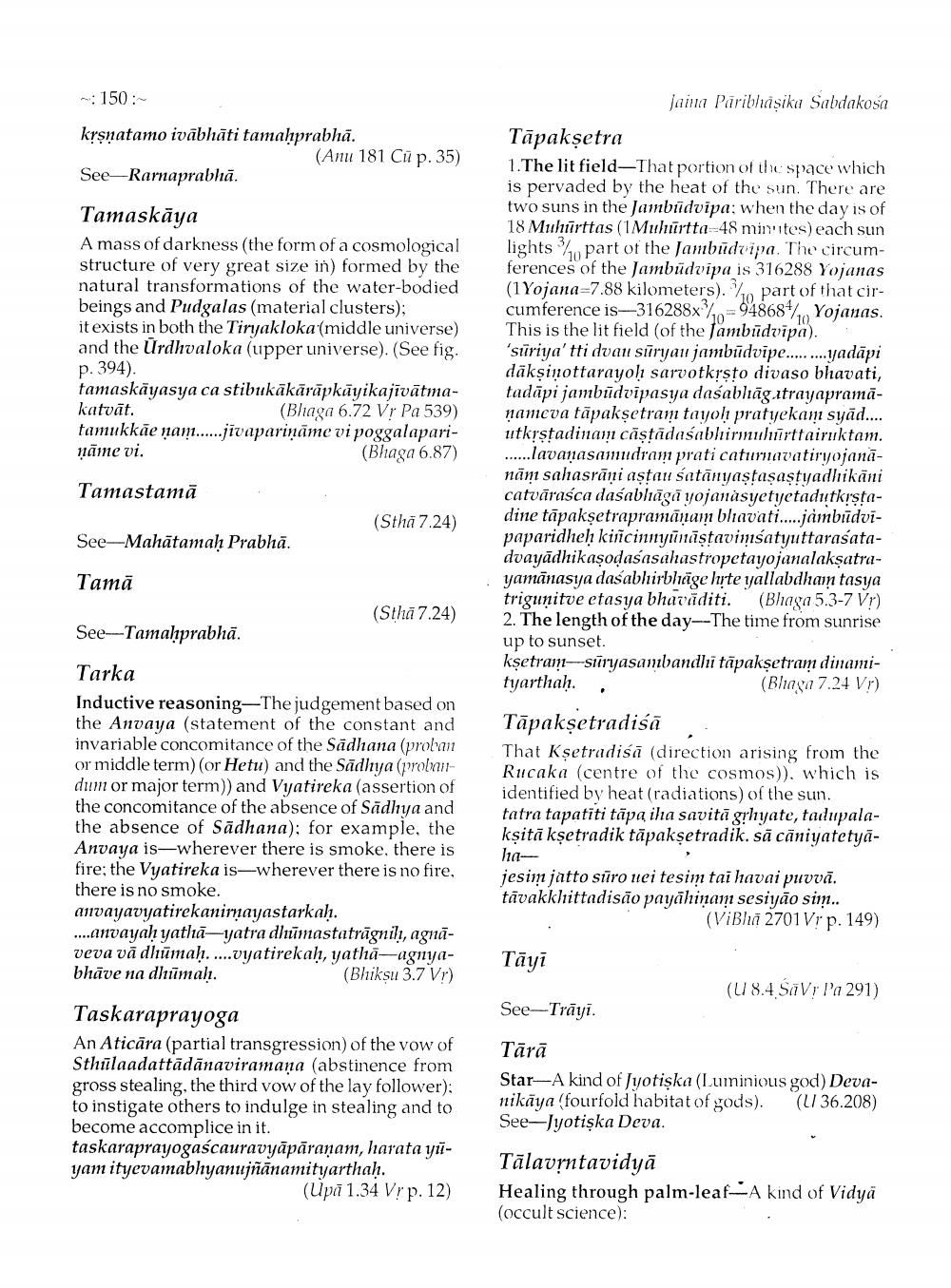________________
: 150:
jaina Paribhasika Sabdakosa
krsnatamo ivābhāti tamahprabhā.
(Anu 181 Cū p. 35) See-Rarnaprabhā.
Tamaskāya A mass of darkness (the form of a cosmological structure of very great size in) formed by the natural transformations of the water-bodied beings and Pudgalas (material clusters); it exists in both the Tiryakloka (middle universe) and the Urdhvaloka (upper universe). (See fig. p. 394). tamaskāyasya ca stibukākārāpkāyikajivātmakatvāt.
(Bhaga 6.72 V? Pa 539) tamukkāe nam.....jivapariņāme vi poggalapariņāme vi.
(Bhaga 6.87)
Tāpakşetra 1. The lit field-That portion of the space which is pervaded by the heat of the sun. There are two suns in the Jambidvipa: when the day is of 18 Muhurttas (1Mulurtta-48 minutes) each sun lights part of the Jambūdvipa. The circumferences of the Jambūdvipa is 316288 Yojanas (1Yojana=7.88 kilometers). part of that circumference is-316288x?=94868/ Yojanas. This is the lit field (of the fambrīdvipa). 'suriya'tti dvau süryani jambūdvipe........yadāpi dākṣinottarayoh sarvotkrsto divaso bhavati, tadāpi jambūdvipasya daśablāg.itrayapramanameva tāpakşetram tayoh pratyekam syād... utkystadinam cāstādaśabhirmulirttairuktam. ......lavanasamudram prati caturnavatiryojananäm sahasrāni aştau satanyaştaşastyadhikäni catvārasca dasablāga yojanasyetyetadatkrstadine tāpakşetrapramānain blavati.....jambiidvipaparidheḥ kijicinnyünāstavimšatyuttarasatadvayādhikasodaśasahastropetajojanalaksatrayamānasija daśablirbhāge hyte yallabdhain tasya trigunitve ctasya bhavāditi. (Bhaga 5.3-7 V!) 2. The length of the day--The time from sunrise up to sunset kşetram---suryasambandhi tāpakşetram dinamityarthah. .
(Bhaga 7.24 Vr)
Tamastamā
(Stha 7.24)
See-Mahātamaḥ Prabhā.
Tamā
(Sthā 7.24)
See-Tamahprabhā.
Tarka Inductive reasoning—The judgement based on the Anvaya (statement of the constant and invariable concomitance of the Sadhana (proban or middle term) (or Hetu) and the Sādhya (jolandum or major term)) and Vyatireka (assertion of the concomitance of the absence of Sādhya and the absence of Sādhana); for example, the Anvaya is—wherever there is smoke, there is fire; the Vyatireka is—wherever there is no fire, there is no smoke. anvayavyatirekanirnayastarkaḥ. ....anvayah yatha-yatra dhūmastaträgnilt, agnāveva vā dhūmaḥ. ....vyatirekah, yatha--agnyabhāve na dhūmah.
(Bhiksu 3.7 Vr)
Tāpakşetradisā That Kșetradisā (direction arising from the Rucaka (centre of the cosmos)), which is identified by heat (radiations) of the sun. tatra tapatiti tāpa iha savitā grhyate, tadupalakṣitā kşetradik tāpakşetradik. sä сāniyatetya
110
jesim jatto sūro uei tesim tai havai puvvā. tāvakklittadisão payāhinam sesiyāo sim..
(Vibha 2701 Vr p. 149)
Tāyi
(U 8.4 SãVr Pa 291)
See-Trāyi.
Taskaraprayoga An Aticāra (partial transgression of the vow of Sthilaadattādānaviramana (abstinence from gross stealing, the third vow of the lay follower); to instigate others to indulge in stealing and to become accomplice in it. taskaraprayogascauravyāpāraṇam, harata yüyam ityevamabhyanujñānamityarthah.
(Upā 1.34 Vr p. 12)
Tārā Star- A kind of Jyotiska (Luninious god) Devanikāya (fourfold habitat of gods). (L 36.208) See-Jyotiska Deva.
Tālavrntavidyā Healing through palm-leaf-A kind of Vidya (occult science):




